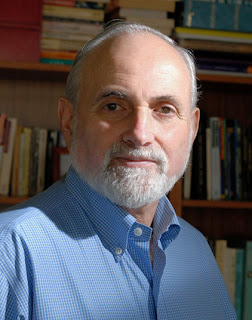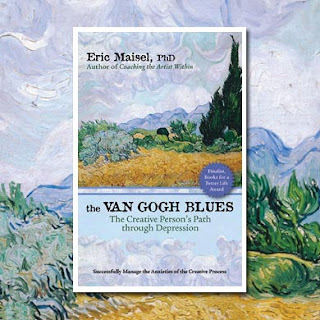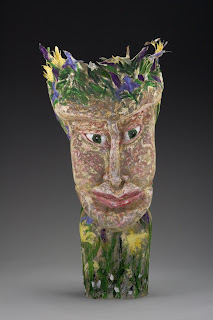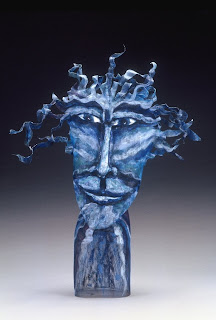
"THE VAN GOGH BLUES, The Creative Person's Path through Depression"
AN INTERVIEW WITH AUTHOR ERIC MAISEL
Today I'm so pleased to talk to Eric Maisel, author, creativity coach and psychotherapist whose books, newsletters and podcasts have helped so many creative people succeed. I know his books have offered me advice, inspiration and guidance along the sometimes long and winding creative road. And this book comes from one creator to another. Eric Maisel, a writer himself, knows first-hand the struggle creative people experience and in this book, he address the problems and seeks to lead all of us out of the blues.
Why do creators experience depression? According to Eric Maisel, "Creators are not necessarily afflicted with some biological disease or psychological disorder that causes them to experience depression at the alarming rates that we see. They experience depression simply because they are caught up in a struggle to make life seem meaningful to them. People for whom meaning is no problem are less likely to experience depression. But for creators, losses of meaning and doubts about life's meaningfulness are presistent problems-even the root causes of their depression." Eric calls this a 'meaning crisis'.
Question: Eric, how do I restore meaning during a meaning crisis?
Eric: First, you need to have the kind of vocabulary of meaning in place that allows you to accurately name your current difficulty as a meaning crisis. Then, having correctly identified it, you need to remind yourself forcefully that you make the meaning in your life and so it is on your shoulders to either reinvest meaning where it just got lost or make a meaning investment in another direction. That is, you must decide if your current novel, which suddenly feels meaningless to write, is still worth your attention, in which case, you reinvest meaning in it, or whether your must abandon it and start another project. You restore meaning by actively and consciously either reinvesting meaning or make a new meaning investment.
Q: Facing that novel on the computer screen, a blank canvas or a lump of clay, how can I move through my fear or meaning crisis and keep creating?
Eric: The first step is to notice that fear or anxiety is at play, rather than mislabeling the situation (for instance, by suddenly deciding that you have no talent or that your paintings will never be wanted). The second step is to embrace this anxiety, rather than trying to fend it off. Anxiety is natural and, at modest levels, no particular problem - the problem is fighting like heck to avoid the experience of it. So you embrace it and say, "Gee, I am feeling a little anxious." Just saying that will help. Next, you use some anxiety management technique to reduce your experience of anxiety: just taking a few deep breaths can work wonders. Label it correctly, normalize it, and then reduce it.
Q: So I've recognized my anxiety and taken a few deep breaths, but I'm still not getting my studio work done. I say, I'm too busy or too tired. Or I'd love to sculpt a new clay figure but I don't have a kiln to fire it in. Am I sabotaging my own efforts? And why would I do that to myself?
Eric: Because creating is difficult, and because we want to keep that truth out of conscious awareness, we act as if we want to create but then find ways of avoiding it. The most characteristic ways we avoid it nowadays is to say to ourselves, "I'm too busy" and "I'm too tired, " both of which work to keep us from our art because they have enough of a grain of truth to them that we can comfortably buy them. The most classic way to avoid the hard work of creating is to use some 'yes, but' construction, which translates as, see, I really wanted to do it(sculpt), but, darn it all, something monumental is in the way(no kiln). If you point out that there is a kiln thirty miles away, what will you get in reply? - a new 'yes, but.'
Q: Working daily at my art, how do I measure success and feel more successful?
Eric: The typical way that a creative person measures success is according to how well his creation is received by the world. If he finds a publisher for his novel, he designates that a maker of success. If the novel sells well, he considers that another . But what marker will he use during the 600 days he is writing his first novel? It can't be publication or sales: it must be that he is showing up and honorably working. If he does not consider markers like those and if he doesn't celebrate those sorts of successes on the days that he shows up and works, he is likely to feel too little rewarded and too unsuccessful and give up on creating. We must decide to feel successful as we proceed, because external validation is not going to come often enough to meet the need we have to feel successful.
Thank you, Eric. And that's gets me right back to the core of creativity. I create because it is meaningful to me and important to me to do it. And by doing my creative work everyday, whether it's sculpting, writing or painting, I feel successful. I am a meaning maker.
For more about Eric Maisel and his books, workshops and consulting services, be sure to visit www.ericmaisel.com




